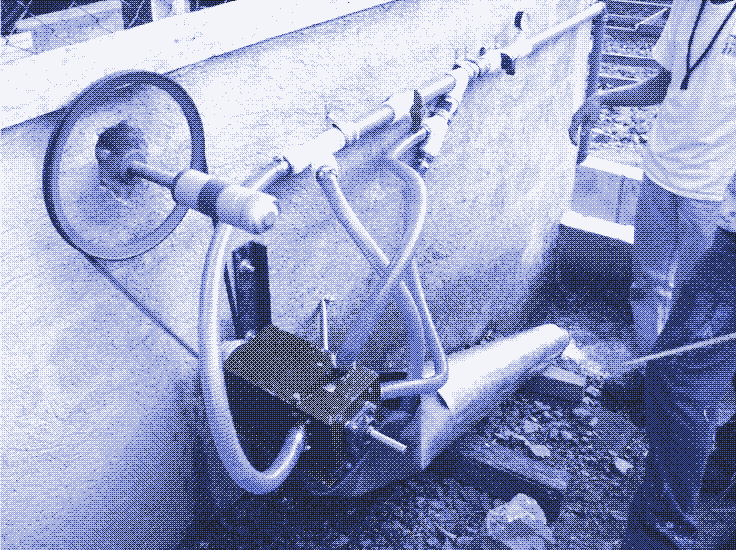
All hydropower plants today produce electricity. Transforming energy to electricity seems to be the only way to harness water power, but it is not. For almost two thousand years, water wheels powered machines directly via mechanical transmission.
Some small direct hydro powered systems in South America present a strong case for combining the use of modern materials with old fashioned methods of water power mechanization.
The higher efficiency of this approach means that less water is needed to produce a given amount of energy. This lowers the cost of hydropower and enables power to be produced by the use of very small streams.
The hydro power installations in use today are actually less efficient than those of earlier centuries
Throughout the course of history, the efficiency of water powered prime movers has steadily increased. Wooden water wheels, which appeared more than 2,000 years ago, converted a relatively small amount of water energy into mechanical power: The efficiency was 5 to 15% for an horizontal water wheel, 20 to 30% for a vertical undershot water wheel, and 50 to 60% for a vertical overshot water wheel. 1
Iron water wheels, which appeared in the late 18th century, had improved the efficiency rating of the vertical overshot wheel to 65 to 85%. 1 Water turbines, which were developed in the 19th century, and which are the water-powered prime movers that we still use today, generally convert over 85% of the kinetic energy inherent to the water source into mechanical power at the shaft of the turbine. 2
Water turbines are ten to twenty times more compact than water wheels for the same power output, an advantage that led to much cheaper and much more powerful prime movers. Turbines are more widely applicable than water wheels, because water wheels could not make efficient use of any head of water (the vertical distance travelled by the water) much greater than their own diameter. 1
Why Modern Hydro Power is Less Efficient
In spite of these significant improvements, hydropower installations today are actually less efficient than those from earlier centuries. The culprit is electricity. Not long after the introduction of the water turbine, another change occured. Instead of using water-powered prime movers to run machinery directly (as had been the case for centuries), water turbines were (and still are) used to generate electricity. This modern approach has introduced an energy deficit that has nullified any progress behind hydropower design efficiency.
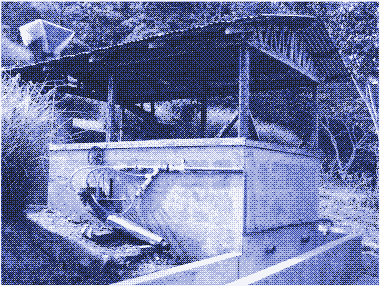
In a modern hydropower installation, a water turbine converts the energy in the moving water into rotational energy at its shaft, which is then converted into electrical energy by the generator that is coupled to the turbine. Next, the electrical energy is converted back into rotational energy by the electric motor of the machine that is being powered. Every energy conversion introduces energy loss.
This loss of energy occurs due to friction, which is observable as heat, vibration and noise. Friction occurs at all levels of electrical transmission: In the turbine, the generator, and the motor. Additional components such as batteries, drive systems and inverters can further increase efficiency losses.
It is possible to calculate the efficiency rating for each modern hydropower unit by measuring the difference between turbine input and electric generator output. A home-sized hydropower plant generating AC electric power has a “water-to-wire” energy transfer of at best 60 to 70 percent. Smaller DC electric systems, which require inverters and generally have battery banks, have lower efficiencies of 40 to 60 percent. 3
Energy loss in the electric motors of the devices being powered is not included but should also be considered (“water-to-motor” efficiency). The efficacy of an electric motor can vary wildly - from less than 60% for small motors to more than 95% for large motors. On average, a hydro-electric power installation only converts about half of the energy available in water into useful work.
A direct hydropowered coffee depulper in Nicaragua has been performing flawlessly through five harvests
This means that a small, modern hydropower plant has a similar efficiency rating to a centuries old configuration using a wooden vertical overshot water wheel (50-60%), and that this modern counterpart is considerably less efficient than the iron water wheels of the 18th century (65-85%).
In an old fashioned hydropower installation, there was only one conversion of energy; A water wheel converted the energy inherent to the water source into rotational energy at its shaft. The same shaft also moved the machinery, so that the only source of significant energy loss occured in the water wheel itself. 4
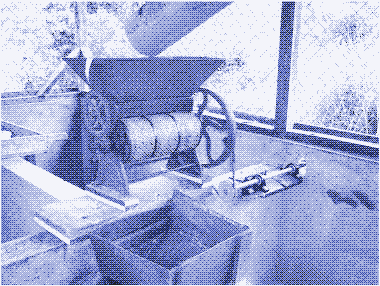
Note that this is not the total efficiency of the hydropower installation: friction also occurs in the pipeline that feeds the water to the turbine. Most small hydropower systems don’t use dams. Instead, they divert a fraction of the water of a stream downhill through a pipe. The energy losses in the pipeline are the same for hydroelectric and direct hydropower installations. Therefore, for the purposes of our comparison, these power losses can be overlooked.
Why Direct Hydropower Makes Sense
There is one possible hydropower configuration in particular that deserves considerable attention: a water turbine directly powering machinery, without the intermediate step of generating electricity. Depending on the type of turbine used in such a system, the value that corresponds to the “water-to-motor” efficiency is roughly 80 to 95%. The implementation of this form of direct hydropower doubles the effectiveness of a small scale electric hydropower installation. 4
The higher efficiency of direct hydropower brings important advantages. If the intermediate step of generating electricity is bypassed, considerably more power can be gathered and utilized from a given head (the vertical distance travelled by the water) and water flow rate (the amount of water that runs down a stream). This advantage can be used to increase the energy production of an existing water power site. It also means that more potential water power sites become available, and that relatively small streams and rivers can be shared by several hydropower units.
Because of its higher efficiency a direct hydropower system is also cheaper than a hydroelectric power system. Less water is needed to produce a given amount of power, which means that all components of the installation are reduced in size, cost, and other resources. For instance, less civil engineering is required. Water can be carried to the turbine by low cost, low pressure, easily transportable, flexible, plastic tubes that are small in diameter as opposed to the rigid, large diameter penstocks common to electric hydropower plants. The flexible connections between the pressure pipe and turbine also simplify installation.
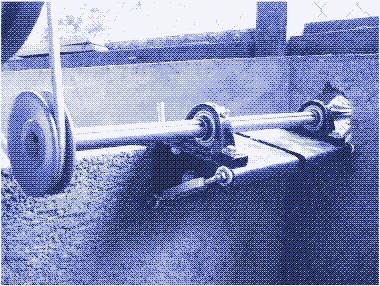
Last but not least, the higher efficiency of direct hydropower limits the ecological impact of a water power site. Maintaining enough water in the power source for aquatic life to thrive is a cornerstone of environmentally sound microhydropower production. This type of ecological sustainability is easier to achieve with direct hydropower because less water is required.
Old-School Approach, Modern Materials
Many NGO’s are introducing small hydropower systems in the developing world. Almost all of them are aimed at the production of electricity. However, there are a few exceptions to this standard practice. In 2007, a team from the Appalachian University in the US designed, built and installed a direct hydropowered coffee depulper in Nicaragua. According to a recent study in Energy for sustainable development, it has “performed flawlessly through five harvests”. 5
Because less water is needed to produce a given amount of power, all components of the system are reduced in size and cost
Much of the necessary energy for coffee harvesting and processing is provided by manual labour. One of the most tedious, labour intensive steps of coffee bean processing is depulping. In the past, the depulping process was restricted to a hand cranked machine, and would take all night to complete. Now, with the help of direct hydropower technologies, the depulping can be completed in two or three hours.
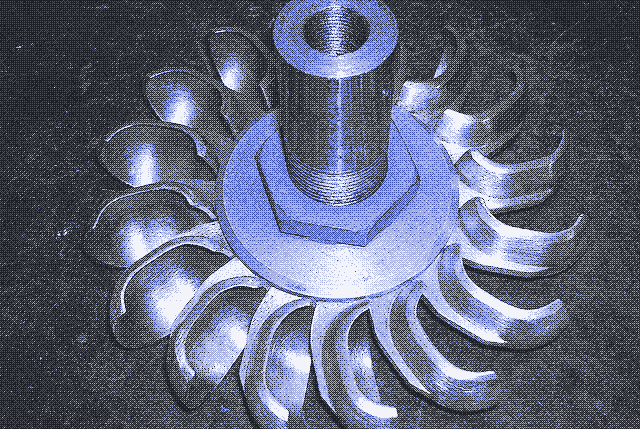
The installation can deliver a maximum of 800 watt mechanical power with a head of 35 m and a water flow of 300 liters per minute. The material costs amounted to just $1900. For comparison, Practical Action states that, when using appropriate technologies, a small scale hydroelectric installation costs $1,800 to $6,000 per installed kilowatt. It takes about two kilowatts of mechanical power to produce one kilowatt of electric power, so that direct hydropower is at least twice as economically viable as a hydroelectric operation with the same rate of energy production.
Precise Control
The turbine used by the direct hydropowered coffee depulper is a commercially available Water Motor model 90 from Campo Nuevo in Bolivia. According to the manufacturer, the compact machine (16 x 16 x 32 cm) is “the only modern turbine designed to drive common machines directly with water power”. The turbine uses a 9 cm diameter Turgo type runner, which converts water power into mechanical power at 80 to 85% efficiency. It is suited for moderate to high head systems. The larger model 150 has a 15 cm diameter runner and produces about three times as much power.
The water motor is as easy to control and adjust as an electric motor. It has a power switch that allows instant on/off control, which makes it practical to directly power machines which must be turned on and off many times during use. The mechanism works by deflection of the water from the runner, so that the force of the flow does not increase the pressure in the penstock.
The power output of the turbine can be precisely adjusted. Like any other turbine of the impulse type, a Turgo runner is driven by high velocity jets of water. A manifold separates the water flow into four smaller tubes, with each stream leading to one of the four jets driving the turbine wheel.
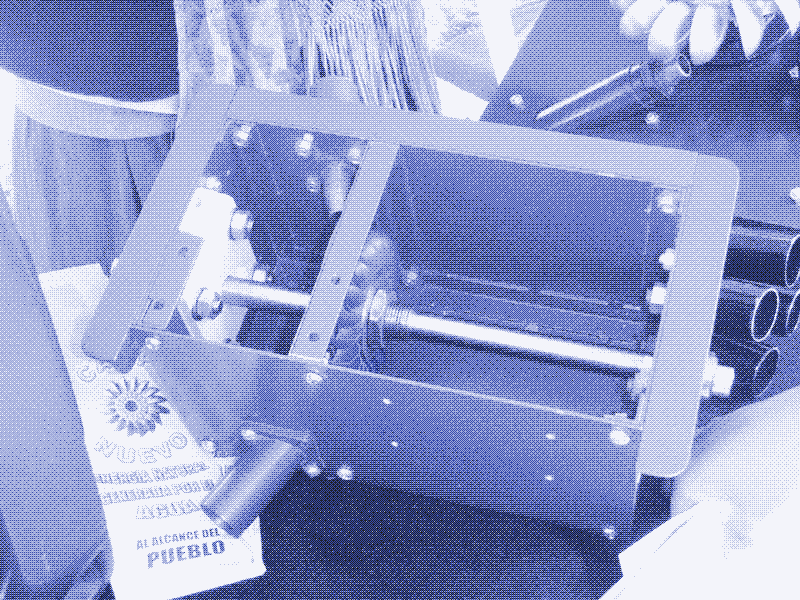
Each of the four nozzles has an individual valve to provide for a range of flows, so that the motor can be run on one to four jets at a time. Furthermore, the jets can be adjusted to various sizes. This mechanism makes it possible to precisely measure and adjust the power output of the motor and cater to seasonal variations in water flow.
Direct Hydropowered Woodworking Unit
At the Campo Nuevo demonstration site in the Andes, the water motor runs a large variety of machines, including a small woodworking unit (table saw, grinder, joiner, drill, abrasive disk), a cement mixer, and a grain mill. When mechanical power is not being used by any of these machines (for instance at night), the motor runs a generator which stores electric energy in batteries for lighting and other purposes. The water motor can also operate an air compressor to run air-powered tools. (In principle, it could also run a compressor from a refrigerator). 6
A small storage tank makes it possible to run even more powerful machines
The water motor on the demonstration site delivers power similar to a 0.75 horse power (560 watt) electric motor at 1,450 rpm using a stream with a vertical fall of 18 m and an average water flow of 310 liters per minute. These conditions are less than ideal for a hydroelectric power site, but for direct hydropower the situation is perfect.
A small storage tank attached to the direct hydropower unit even makes it possible to temporarily run more powerful machines. Since the operation of the table saw requires 500 liters of water per minute (which is often not available), the 6,000 liter storage tank was installed, measuring 2 x 2 x 1.5 m. It allows the table saw to run for 15 minutes continuously. This additional power output adds up over two hours of operating time over the course of a ten hour workday.
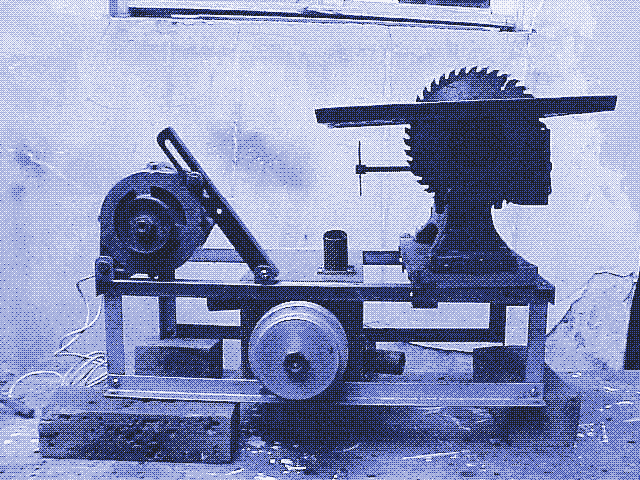
.
All machines (including the generator and air compressor) are placed directly on or beside the turbine housing. These tools are attachable to (and driven by) the same belt. The water motor can only operate one machine at a time, since there is no distribution of energy. This works well in a workshop, because many tools and machines are used intermittently.
The same configuration is used for the direct hydropowered coffee depulper in Nicaragua, which was described above. Coffee beans are harvested from December through February, and they must be depulped within 24 hours of picking. This processing constraint means that the depulper is only used at night for a small fraction of the year.
Therefore, the direct hydropower installation is often available for other applications (such as running a saw, a drill, an air compressor, or an electric generator). Although the turbine that powers the coffee depulper can provide up to 800 watts of mechanical power, the coffee depulper itself uses only one fourth of that waterpower and one jet to deliver 200 watts for its operation.
Upgrading Medieval Water Mills
Will we see a rebirth of direct hydro power? Maybe, but the fact remains that this form of energy production has never disappeared. In some mountainous regions, there are still water wheels in operation that share similar design with the water mills so extensively used in medieval Europe. The rotating shaft directly drives machinery, most commonly found today as grain mills for flour production.
In remote villages in Nepal, many farmers use all wooden traditional water mills to grind grain. About 25,000 to 30,000 of these are still in operation today. In Nepal, the goal is not to reintroduce direct hydropower, but to make sure that it stays. That is why the national NGO Central for Rural Technology Nepal(CRT/N) runs a program to upgrade these mills. The improved water wheels can grind grain more efficiently and have longer lifespans, which allows them to compete better with diesel powered mills.
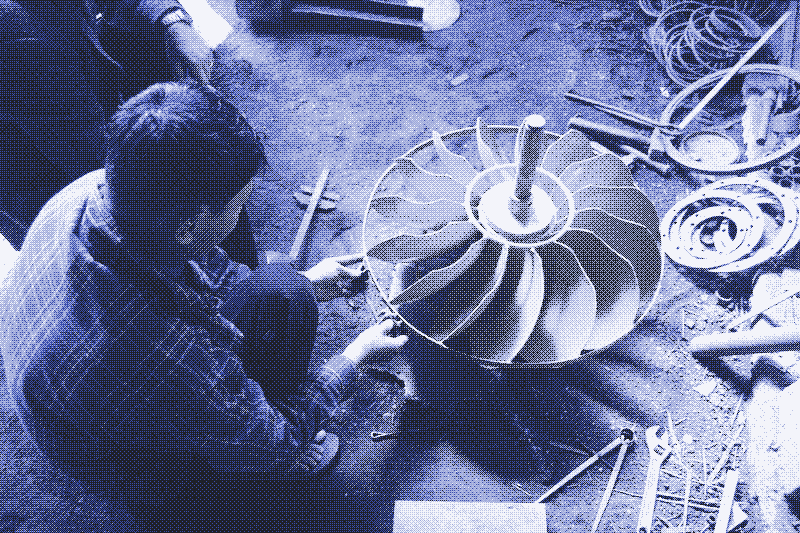
Basically, CRT/N upgrades medieval style water wheels to nineteenth-century style water wheels, by replacing key wooden parts such as the shaft and the runner with locally produced precision metal parts. The wooden penstock that delivers water to the mills is replaced by a high density polyethylene pipe which reduces leakage and other avoidable problems.
In Nepal, an NGO has upgraded more than 5,000 still operating all wooden water mills to nineteenth-century standards, doubling their efficiency and allowing them to compete with diesel power
CRT/N calls its technology the Improved Water Mill (IWM). Estimates suggest that grinding capacity of the upgraded mills has doubled, which corresponds neatly with the efficiency figures we introduced at the beginning of this article. The higher efficiency makes that less water is needed and that the mills can operate for longer periods of the year.
Replacing Diesel Engines
The NGO has upgraded 5,700 water mills from 1990 to 2009. Some of these upgrades (237 to be precise) also involved adapting water mills so that they can run other machines as well, such as oil presses, rice de-huskers, sawing machines, or an electric generator. To achieve this variability, a longer shaft is installed which disconnects the runner from the millstones. Instead of connecting to the millstones, the grinding shaft operates from the long shaft using a belt drive, allowing other machines to be operated by direct hydropower.
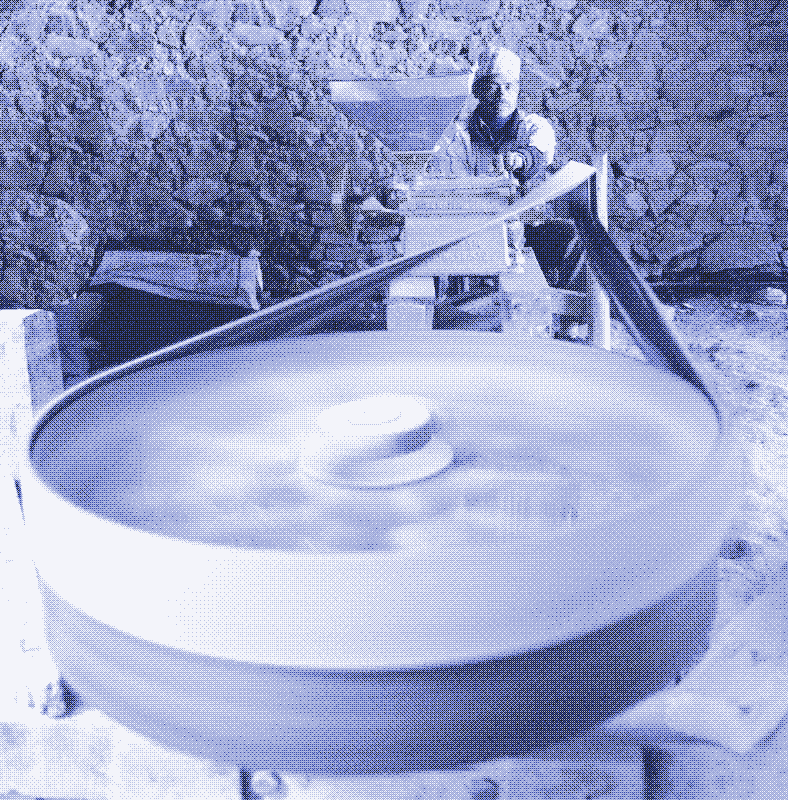
While these upgraded water wheels do not achieve the high efficiency of direct hydropower installations using turbines, they are less expensive. Basic upgrades of a water mill cost $350, whilst the option of running multiple machines brings the total cost at $900 to $1,200. Thus, upgrading a traditional water mill is at least two times cheaper than installing a complete new, turbine driven direct hydropower system. In Nepal, improved water mills have even replaced some diesel powered grain mills, because they are less expensive to run and produce better quality flour.
The water mill upgrade project is still ongoing. Similar but much smaller projects have been implemented by IT Power India, also in the Himalayas (70 upgraded mills at a cost of $200 each), and by SITMo in the Philippines (as part of a mostly electric hydro scheme).
The best of both worlds
This plea for direct hydro does not imply that we should stop using electricity. Some things cannot be powered by mechanical energy, most importantly lighting and electronic equipment. Furthermore, many people in the developing world do not have access to electricity at all, forcing them to use unhealthy kerosene lamps instead.
Rather, the examples described above show that it might be interesting to combine both methods. The best results would be obtained by a hydropower installation that produces mechanical power for operating machines, and stores electric power in batteries for lighting and other purposes when mechanical power is not required (for instance at night). Compared to a strictly mechanical system, it would offer important extra benefits. Compared to a merely electric system, it would deliver more power and be much more efficient.
Water motors can also be used if you don’t have a mountain stream running next to your house, farm or factory. That’s the topic of the next post: Power from the tap: water motors.
Reactions
To make a comment, please send an e-mail to solar (at) lowtechmagazine (dot) com. Your e-mail address is not used for other purposes, and will be deleted after the comment is published. If you don’t want your real name to be published, sign the e-mail with the name you want to appear.
Reactions
Marcel Haenggi
There were interesting systems of direct use of hydro power at Lake of Zurich (and probably elsewhere) in late 19th century. In the heights close to the villages there were little artificial lakes (“Weiher”) which provided a network of pipelines with high pressure water. Any factory or crafts workshop in the village could get connected to the system for a fee. The water than powered the machines. On sundays when factories did not work, the water was used for waterspou fountains, some of which still are active today or have been re-established (e.g. in Richterswil: http://www.fontaene.ch/typo3temp/pics/5f7b1245bd.jpg ; http://www.fontaene.ch/typo3temp/pics/a70c569059.jpg ; http://farm6.staticflickr.com/5106/5628095345_7e53a35a78_z.jpg).
Alfred Max Hofbauer
Any kind of energy can be transformed into any other kind… Here is a list of the known types: http://en.wikipedia.org/wiki/List_of_light_sources
I´ve been trying sonoluminescence and triboluminescence (even into the X-ray spectrum).
A friend of mine made a “hydraulic LED”, years ago, drilling a T-junction of hydraulic lines into a block of clear plexiglass. It lit only when the flow ran in one direction.
Matthias
Nice article about rotary hydropower.
i was swimming in the lake today. In the bath the have a small lift. It is used to lift handicapped people in and out the water. The lift is powered with water from a garden hose. Basically the lift is an hydraulic cylinder with two valves and a chair attached to it.
Many machines use hydraulic or pneumatic cylinders. Electric cylinders are still expensive. With hydraulic cylinders we can power lifts, rams, scissors, presses, dumpers, gates, cranes and much more.
Many tools are still operated pneumatically which is the most expensive form of energy. £he could be constructed to run with water.
Look at modern construction machines like an excavator. The diesel prime mover is powering the hydraulics. The caterpillars are powered by hydraulic motors and all the rest by hydraulic cylinders. If we have enough pressure it should be possible to convert a machine from oil hydraulic to water. With a flexible hose it would be possible to operate construction machines. Houses bridges and tunnels could be built just with water hydraulics.
Kris De Decker
@ Marcel: That’s correct. These and other systems will be discussed in the next post.
@ Alfred: Interesting. I thought that a light bulb required electricity. An LED does for sure, because its operation is based on moving electrons. The same goes for computerchips. Whatever power source you use, you will always have to convert the energy to electricity. Are non-LED light bulbs different?
@ Matthias: Exactly. See upcoming post.
Laurent S
There is a loss when you produce electricity, but you can use electricity anywhere. Direct hydropower means that you have to carry the wood, the seeds,… to the hydropower plant, and then you will also lose a lot of energy. So the ratio win/loss is more complex to calculate.
Paul
Did you know that electric motors are the single biggest users of electricity in the world; using almost half of all of the world’s electricity. I would agree with you that, in some instances, using mechanical energy from a turbine/waterwheel to generate electricity to power a motor and turn the energy back into mechanicl energy is slightly stupid. However, I would add that, in my opinion, this mechanical energy might not be as easy to transmit as electricity over distances of more than several metres or to serve multiply users at once and inconsistent load that are continually coming on and offline and/or changing speeds. The resaon why I think that most hydropower projects are for hydroelectricity is be more flexible and possibly user friendly because a river won’t light your house and you can’t recharge a cellphone with a stream
Drake
Water wheels are great but not everyone has a stream and a good head of water. A deep well and a small head of water can be used to compress air in a “trompe”. Bubbles flow down and are compressed and captured in an air chamber. The deeper the well the higher the pressure. The greater the head the faster the flow. Compressed air is versatile and since it is expensive if produced by electricity a deep well trompe might be worth drilling.
Attila
electricity won the role of the transportation of energy, not the production of it, as is shown with small hydro energy too
with the image above, in the article, we are locked having a stream with a given head fall and water amount, which may not be accessible where it just needed - the wire can be used to transport it to the right location, time, and size
however, i like the idea for direct mechanical use of water energia, but rather as energy storage, than energy production
so, i have an intermittern energy source, let it be an own wind mill, off-peak grid electrical energy, or a combuston engine running on wood gas
i can use the mechanical primary energy to pump up water to give it a height based energy, and then when i use it, release it down, through water wheels, either reproducing electricity again, or use it directly
j walker
You may be interested in this:
http://ludens.cl/paradise/turbine/turbine.html
he’s a retired Electrical Engineer living in Chile who set up his own 4kw hydro plant essentially from scratch with help from 2 or 3 other people. It’s pretty amazing.
Eideard
Paul’s comment [7] is partly correct. At least a third of those electric motors are actually pumps of one sort or another. Either moving fluid or air. Heating or cooling buildings, especially commercial buildings. Luddites also have a problem with trying to accommodate commercial enterprise of today’s size and breadth - running out of sites for hydropower torque quickly.
Trying to replace electricity in any serious production of commodities, sale and use, is hilarious.
zeev
the problem with direct mechanical power is always about power transmission limiting the distance from the power source to the factory itself.
as you yourself wrote about, you got stagenkunst, jerker lines, then you have pulley lines as used for older streetcars. power can physically transmitted over distance in mechanical form by pulling or pushing. as spinning direct drive shafts cannot extend for any meaningful distance .
given this is the case, you either have a problem of having to build a factory on site, or needing to first convert the energy to electrical form for sending it a few kilometers to the location for building the factory.
this is why and how the design of hydroelectric damns make sense.
mechanical direct hydropower is obviously superior as is any direct power method. but direct power is too limiting and is thus superior only in the very narrow number of situations where it can be made useful RELATIVE to those made possible by hydroelectric power generation.
articles like these just contextualize technology in order to emphasize the superior aspects of simpler technologies….
cFarmer
Perhaps it would make more sense to say that Direct hydropower is more efficient “in the moment”. This would clarify its true advantages, while simultaneously admitting to its disadvantages.
Unless a Direct hydro plant such as the one in Nicaragua is Depulping coffee 24 hours a day, 365 days a year, then all of those hours of non-productive time begin to add up considerably and completely erode any inherent advantage of momentary efficiency.
Even if one considered the low end of the spectrum of efficiencies for a small battery and inverter hydro electric plant(30%), when one considers the overall productivity thru time for the plant, electric plants will usually come out way, way ahead since they can store the electricity in batteries.
In addition, almost all small hydro electric plants have diversion capabilities, so that as the batteries themselves get full, then any excess electricity is diverted to a whole suite of other potential uses, such as hot water heating.
You did reference these potentials in your article - of using surplus water power to run all sorts of electrical devices.
Once again, my recommendation would be not to say that “Direct Hydro is more efficient”, because for 99% of cases, this simply is not true.
But instead to say that “Direct Hydro is more efficient in the moment”.
Combine this fact with the fact mentioned by other commenters about the advantages to Hydro electric for power transmission, and hydro electric just runs circles around direct transmission.
Of course, what is left for Direct Hydro beyond any momentary advantage in efficiency is the much cheaper up front capital costs - as you mentioned - which is admittedly a huge advantage to many folks in the world.
Thanks for the article.
Slowburn
@ 11 Eideard
You are really unable to get out of the box. It’s tragic really. Do you also complain when someone is so greedy that he finds a use for all the byproducts of his operation and stops dumping waste into a river?
John Paul
35 m of head and 300 L/s flow gives almost 100 kW of power so there’s power to spare here.
800 W (mechanical) for $1900 isn’t much of a bargain with 1500 W (electrical) turbines going for $1600 (2016). An 800 W electric motor costs a few hundred dollars.
The opportunity cost here is pretty big since the mechanical system can only be used for one purpose and probably for only 8-12 hours per day.